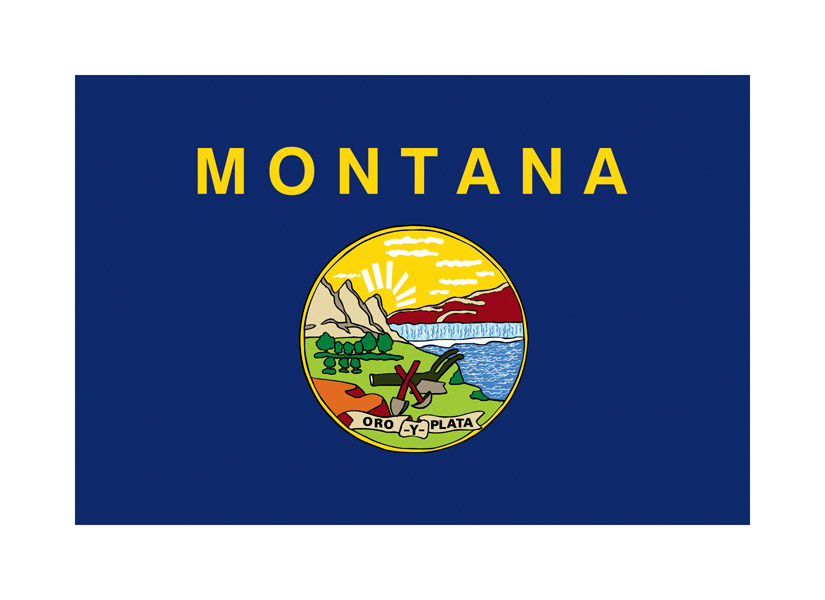Presented here are brief descriptions of 35 naturally occurring vegetative cover types that were used to characterize prevailing vegetation of Ecoregion "sections" of the conterminous United States. Cover types may be visualized as the general, natural vegetation viewed from an aerial perspective. These cover types are used for descriptive purposes in the section narratives and should not be confused with potential natural vegetation (PNV), which was used in the process of identification and delineation of larger ecological units. Some cover types are similar to PNV, particularly in forested regions. Other cover types, such as the prairie type, are present only in small areas that have been changed to agricultural type. For example, cover types may result from exclusion of some types of natural disturbance, such as fire, and include planned disturbances, such as harvesting.
The Douglas-Fir
Cover Type
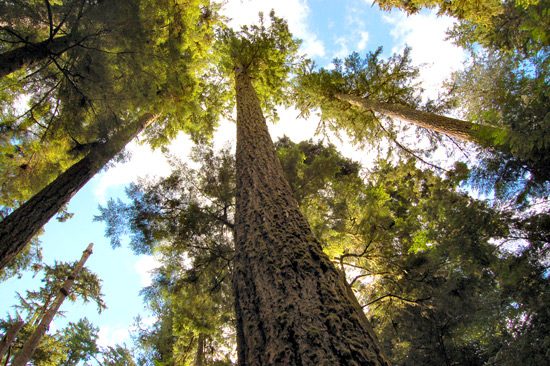
Physiography
The Douglas-fir cover type encompasses one of the larger blocks of western timber in that it includes much of the mountains in western Oregon and western Washington and extends well south into the northern California Coast Ranges. It is an extensive cover type, for there are large acreages of it in the northern Rocky Mountains and lesser scattered areas in the Blue Mountains of Oregon and the middle and southern Rocky Mountains. The elevational range is great, from 500 feet up into the high mountains.
Climate
The length of the frost-free season is 200 days in western coastal areas and 160 days in the rest of western Oregon and Washington.In the rest of the cover type, the frost-free season is about 80- 120 days. Average annual precipitation is 40-80 inches in the extreme west and 20-30 inches in most of the interior portion of the cover type. In the extreme west, 50-60 percent of the total precipitation occurs during the period December to March.
In the rest of the cover type, only 25-40percent of the precipitation occurs in the coldest months. The amount of precipitation during the frost-free season is equal to, or not less than, 40 percent of the evaporation in western Oregon and western Washington. In the rest of this cover type, precipitation during the frost-free season is only30-40 percent of the evaporation potential.
Vegetation
This cover type is characterized by forest consisting of 50 percent or more Douglas fir, except where redwood, sugar pine, or western white pine comprise 20 percent or more of the stand. Most common ecological descriptions of one of the largest blocks of timber in western Oregon and Washington define it as subclimax stands in areas where the climax is western hemlock-western red cedar.
Common shrubs in the cover type are of the genera of maple, rock spirea, filbert, blueberry, snowberry,barberry, currant, blackberry, ninebark, rose, and spirea. Herbage includes grass and other vegetation having a grasslike growth form, especially in the stands in interior States. Here, pinegrass and Carex concinnoides are present.
Fauna
Common large mammals in this cover type include elk, deer, and black bear. Grizzly bear and moose are in the northern Rockies. Blue and ruffed grouse are present. Most of the northwestern part of the cover type has hawks and owls. Mammalian predators include mountain lions and bobcats. Small mammals include mice, squirrels, marten, chipmunks, and bushy-tailed wood rats. Some of the more common birds are the chestnut-backed chickadee, red-breasted nuthatch, gray jay, and Steller's jay.
Soils
In western Washington and Oregon the soils of this cover type are Inceptisols and Ultisols. In the northern coastal area of California they are Ultisols. In the Blue Mountains of Oregon, the soils are Mollisols with an overburden of very absorptive Vitrandepts. In the northern Rockies the soils are Inceptisols (including considerable areas of Vitrandepts), Alfisols, and Mollisols. In the middle and southern Rocky Mountains, the soils are Mollisols, Entisols, and Alfisols.
Land Use
About 75 percent of the land area is forested, and lumbering is a major industry. Less than 20 percent is in crops or improved pasture. Fruit, vegetables, and grain are the major crops. Forage and feed grains occupy large acreages.
Data Source: United States Department of Agriculture, Forest Service
The Ponderosa Pine
Cover Type

Physiography
Because ponderosa pine has a rather wide range of adaptability and can dominate some of the less mesic true forest sites, it occupies low mountains and foothills in many places; yet in mixtures with other species, it is found at moderate elevations. The extensive distribution of ponderosa pine and associates includes parts of 14 western states from Nebraska to the Pacific coast and from Arizona to Canada. It is the largest western forest type in the United States. Local topography can be gentle, as on plateau tops and low mountains, or it can be steep, as on canyon walls and faces. Semiarid, low mountain sites are common, but it is difficult to characterize the physiography of the cover type because it varies greatly.
Climate
The length of the frost-free season at any location in the cover type depends largely upon the latitude and elevation. In general, in much of the northern area the frost-free period is 120 days, whereas in many foothill areas and in parts of the Sierra and the Gila Mountains of the Southwest, it can be 240 days.
Annual precipitation is about 15-20 inches in the more pure pine areas, but where there are combinations of pine and other conifers at moderate elevations, the precipitation can total 30 inches. In the far western sector, only 25 percent of this moisture falls in the warmest months. In the northern Rocky Mountains, 40-50 percent of the precipitation occurs in the warmest months. In the middle to southern Rockies, 66-75 percent occurs in the warmest months.
In the southern areas and those at low elevations, precipitation during the frost-free season is only 20 percent of the evaporation potential. In northern areas precipitation during the growing season may be as high as 40 percent of the evaporation potential.
Vegetation
By definition, ponderosa pine forest is 50 percent or more of one of these pines: ponderosa pine, Jeffrey pine, sugar pine, limber pine, Arizona ponderosa pine, Apache pine, or Chihuahua pine. The exceptions are those situations where western white pine or sugar pine comprises 20 percent or more of the stand; then these species control the name of the forest.
The impact of logging and ecological dynamics can cause some problems in maintaining good delineation of the ponderosa pine cover type. This cover type is idealized as open and parklike with an excellent ground cover of grasses, sedges, and forbs or with an understory of shrubs of low to medium height. The shrubs, however, may vary from antelope bitterbrush in Oregon to bearmat in the Sierra Nevada in California. In perhaps 60 percent of the area, the idealized open character of the ponderosa pine cover type has changed to that of a dense and growth-retarded stand, particularly in the Pacific Northwest.
Fauna
In the ponderosa pine cover type, the major mammalian influents are the Rocky Mountain elk, mule deer, mountain lion, and coyote. Animals of less importance include the bushy-tailed wood rat, white-footed mouse, bobcat, rock squirrel, cottontail, porcupine, mantled ground squirrel, Kaibab squirrel, and chipmunks. The Kaibab squirrel is rare. It is endemic to this cover type on Arizona's Kaibab Plateau.
The most abundant and important resident birds in the ponderosa pine cover type include the pygmy nuthatch, long-crested jay, sharp-shinned hawk, Rocky Mountain nuthatch, mountain chickadee, Cassin's purple finch, red-shafted flicker, red-backed junco, western goshawk, and western red-tailed hawk. Birds that are common during the summer include the chestnut-backed bluebird, Audubon's warbler, Natalie's sapsucker, western chipping sparrow, horned owl, and band-tailed pigeon.
Soils
The soils occupied by the ponderosa pine cover type vary tremendously. Along the western edge of the Columbia Plateau and the east slope of the Cascade Mountains, they are Mollisols, Inceptisols, Entisols, and Aridisols. In northern and eastern California, ponderosa pine stands are associated with Ultisols. At the northern edge of the Columbia Plateau (Okanogan Highlands) and in much of the northern Rocky Mountains, pine and the related forest types occur on Inceptisols; the soils of the rest of these areas are largely Alfisols and Entisols. In the Blue and Wallowa Mountains of eastern Oregon, pine stands occupy Mollisols. In the middle and southern Rocky Mountains, pines and associates are on Mollisols, Aridisols, Entisols, and Alfisols. Pine stands in the Gila Mountains are largely on Mollisols. The small stands of pine in the Great Basin are on Aridisols.
Land Use
Ponderosa pine lands continue to be producers of softwood that is highly desired for either millwork or framing. The forage supply within the cover type has been highly prized for summer range, because the land is usually high enough to get good precipitation and the forest soils are deep enough to store sufficient water for growing timber and good ground cover. These precipitation and soil characteristics make the cover type productive of forage during the hot months when range forage at lower elevations has dried.
Data Source: United States Department of Agriculture, Forest Service
The Western White Pine
Cover Type
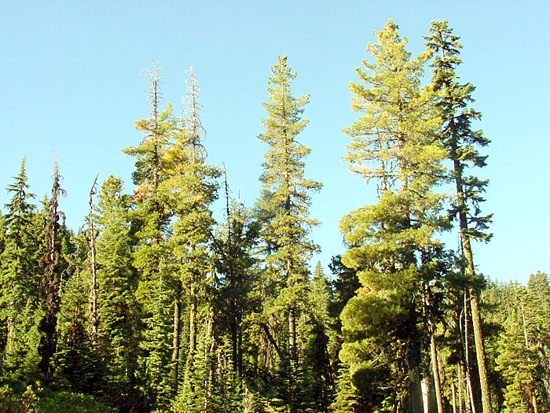
Physiography
The western white pine cover type mainly occurs in the high mountains of the northern Rocky Mountains of western Montana and northern Idaho. It is also in scattered small areas in the Cascade Mountains of Oregon and Washington. Less than 20 percent of the total area is gently sloping, and local relief is more than 3,000 feet. Elevations are mostly 4,000-8,000 feet.
Climate
Annual precipitation in this cover type is 20-30 inches; of this, 60-65 percent occurs during the warmest months. During the frost-free season, precipitation is 20-40 percent of the evaporation potential. The length of the frost-free period is 80-120 days.
Vegetation
Forests in which 20 percent or more of the stand is western white pine or sugar pine characterize this cover type. Kuchler's classification of cedar-hemlock-pine forest corresponds with this cover type. Daubenmire and Daubenmire (1968) would classify western white pine as being in various western red cedar habitats, but also as being seral to some western hemlock and true fir habitats. In summary, western white pine is sometimes found in pure stands yet commonly occurs in mixtures with other conifers. Shrubs and forbs are prominent in the understory, whereas grasses and sedges are minor.
Fauna
The fauna of the western white pine cover type is similar to that of the fir-spruce cover type. The cover type is noted for its population of big game, particularly the Rocky Mountain elk and mule deer. Smaller mammals include the snowshoe hare, long-tailed weasel, marten, coyote, bobcat, and various mice and shrews. The black bear is present. The many birds include the ruffed grouse, chestnut-backed chickadee, red-breasted nuthatch, and Swainson's thrush.
Soils
Most of the soils have formed from ashy materials or have low bulk density and large amounts of amorphous materials, or both. Horizons are weakly developed (Andepts). The most productive sites in this cover type have moist but well-drained soils and occur in valleys and on moderate to gentle slopes with northern exposures.
Land Use
Heavy forests cover much of the land; croplands occupy less than two percent of the cover type. The forests are important for timber production as well as summer cover for wildlife; the area is famous for its elk hunting. Wood of western white pine is soft and highly "workable," like that of eastern white pine; thus, it is valued for a variety of millwork items.
Data Source: United States Department of Agriculture, Forest Service
The Fir-Spruce
Cover Type
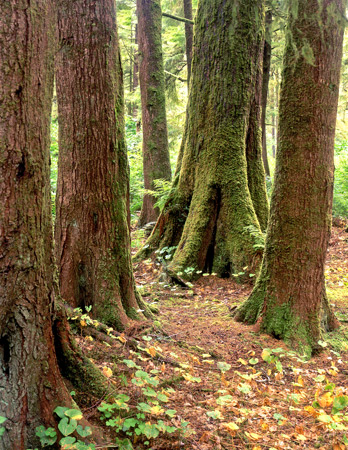
Physiography
The fir-spruce cover type lies within the Sierra-Cascade and the northern, middle, and southern Rocky Mountains provinces. It is normally the highest forest zone in the mountain ranges but varies from as low as 1,500 feet in the Northwest to as high as 12,000 feet in the southern Rocky Mountains. Much of the topography is rough and broken.
Climate
Annual precipitation ranges from somewhat fewer than 22 inches in the Rocky Mountains to 50-75 inches in the Sierras. In the Rockies, 50-65 percent of the precipitation falls in the warmest months, while in the Sierra-Cascade Mountains province only 25-40 percent falls in the warmest months. Precipitation in the period December to March is 50-60 percent of the annual total in the Sierra-Cascade Mountains and 15-25 percent in the Rocky Mountains. During the frost-free season, precipitation is 20- 40 percent of the evaporation potential.
Vegetation
The fir-spruce cover type is characterized by open to dense forests of low to tall needle-leaved evergreen trees and patches of shrubby under growth and scattered herbs. Fifty percent or more of the stand is silver fir, subalpine fir, red fir, white fir, mountain hemlock, Engelmann spruce, or blue spruce, singly or in combination, except where western white pine comprises 20 percent or more of the stand (in which case the cover type would be classified as western white pine). Because of the dense overstory and limited understory, heavily stocked stands are usually not considered a forage resource for domestic livestock unless timber is harvested by patch clearcuts.
Fauna
Seasonally, the fir-spruce cover type and, in particular, the interspersed openings and stream bottoms with broad-leaved woody species such as aspen and willows, are used by moose, elk, mule deer, and white-tailed deer. Mountain caribou originally wintered in Idaho, Washington, and Montana; a few still do. The wolverine, lynx, black bear, mountain lion, coyote, and wolf occur in the cover type. The grizzly bear is present, though in a fraction of its original numbers and is classified as a rare species. Grizzlies are about the only predator of elk and possibly are a useful natural control over excessively large elk herds.
Animals
Several of the species that have been mentioned use the fir-spruce cover type only seasonally, primarily as cover or in following migratory routes. This is the case with the mountain sheep and the mountain goat, which occur more commonly in steep rocky areas. Among the birds in the cover type are several of the blue grouse and spruce grouse groups, ruffed grouse, and various chickadees, nuthatches, bluebirds, robins, and jays. Among the more common rodents and lagomorphs are the porcupine, beaver, snowshoe rabbit, squirrels, flying squirrels, pocket gophers, chipmunks, and various species of mice.
Soils
The soils of this cover type are extremely varied. In the Northwest, Inceptisols (Cryandepts and Cryumbrepts) predominate. Ultisols occur in the Sierra Nevada Range. Alfisols (Boralfs) are common in the Rocky Mountains, and there are also significant areas of Entisols. Areas of deep overburdens of absorptive Vitrandepts are very productive sites in eastern Oregon and the northern Rockies.
Land Use
Heavy forests cover much of the cover type, and they are used as wildlife habitats and watersheds and for recreation and lumbering. There is virtually no cropland. Much of the area is owned by the Federal Government.
Data Source: United States Department of Agriculture, Forest Service
The Larch
Cover Type
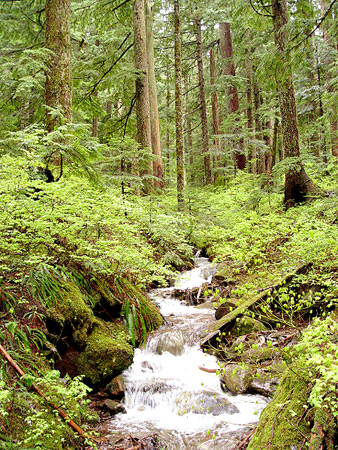
Physiography
The larch cover type occupies the high mountains of eastern Oregon, northern Idaho, and western Montana. Less than 20 percent of the area is gently sloping. Local relief is more than 3,000 feet. Larch commonly occupies the upper slopes or northern exposures at lower elevations of about 3,500 feet.
Climate
The length of the frost-free season in the cover type is 120 days in the Blue Mountains of eastern Oregon and 80-120 days in the northern Rockies. Annual precipitation is 20-30 inches in eastern Oregon and 20-50 inches in the northern Rockies. Of this precipitation, 40-50 percent occurs in the period December to March in the eastern Oregon area and only 35-40 percent occurs in the coldest months in the northern Rockies. During the frost-free season, precipitation is 20 percent of the evaporation potential in eastern Oregon and 20-40 percent in the northern Rockies.
Vegetation
This cover type is characterized by forests in which 50 percent or more of the stand is western larch, except where western white pine comprises 20 percent or more of the timber volume. Ecologically, larch is considered seral to stands of grand fir and stands of Douglas fir. Understory species are commonly of the genera found in spruce-fir stands and some Douglas-fir stands.
Fauna
The fauna in the larch cover type is similar to the faunas of the Douglas-fir and fir-spruce cover types. Larch, however, being a deciduous conifer,lets more light into the stand during part of the year. The difference in the amount of light leads wildlife to prefer the larch stands at times.
Soils
In eastern Oregon, the soils of this cover type are Mollisols, particularly on north and northeast slopes where there is an overburden of deep, absorptive Vitrandepts. In the northern Rockies, they are Inceptisols, Alfisols, and Mollisols.
Land Use
Much of the land is heavily forested, affording wildlife habitats, providing livestock forage, and offering opportunitiesfor recreation, as well as producing timber. Mining is important in northern Idaho and western Montana. A very small percentage of the land is cropped.
Data Source: United States Department of Agriculture, Forest Service
The Lodgepole Pine
Cover Type
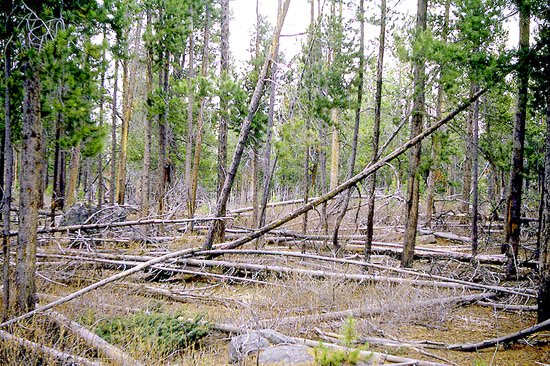
Physiography
The lodgepole pine cover type occupies sites on high mountains of western states. It occurs even in some places where less than 20 percent of the area is gently sloping and at elevations ranging from 4,000-11,500 feet, with local relief more than 3,000 feet. The cover type, however, is best developed on gentle mountain slopes.
Climate
Commonly, lodgepole pine is on sites where the length of the frost-free season is 80-120 days,but it seems to be tolerant of frost at almost any time of year. This species grows where the average annual rainfall is as low as 20 inches, but it can grow well with 50 inches of precipitation. During the frost-free season in lodgepole pine areas, precipitation is commonly 20 percent of potential evaporation and is often 40 percent.
Lodgepole pine stands are adapted to varied distribution of rainfall. In the southern Cascade Mountains and the mid-Sierras, lodgepole pine stands receive 50-60 percent of their annual precipitation in the period December to March. Yet, in the middle Rockies they receive only 15- 35 percent of their precipitation in this period.
Vegetation
This cover type is characterized by forests in which 50percent or more of the stand is lodgepole pine. Ecologically, lodgepole pine stands are seral to some of the western interior coniferous forests. "Doghair" stands often develop after fires. Understory species, if present, are of about the same genera as found in stands of western larch, spruce-fir, and interior Douglas fir.
Fauna
The lodgepole pine cover type has about the same fauna as Douglas-fir, larch, and spruce-fir forests of the same elevational zone. Low productivity of understory flora in many cases limits the number of animals that can be supported. Islands of uncut lodgepole pine provide excellent escape routes and protective refuges or cover for big gameanimals.
Soils
In the Sierras, the lodgepole pine cover type occupies Ultisols. In the eastern Cascades of Oregon, it occupies Entisols. In the Blue Mountains of eastern Oregon, lodgepole pine grows best on Vitrandepts, which deeply overburden bedrock or Mollisols. In the Rocky Mountains, this cover type occupies Inceptisols, Mollisols, and Alfisols.
Land Use
Much of the land of this cover type is forested. About 80 percent is owned by the Federal Government. In addition to producing timber, the forest yields water, affords wildlife habitats, and provides opportunities for recreation. Several national parks are in the area of this cover type.
Data Source: United States Department of Agriculture, Forest Service
The Western Hardwoods
Cover Type
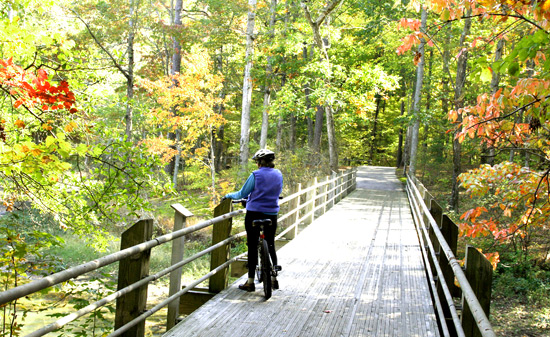
Physiography
The western hardwoods cover type occurs in northern California and southern Oregon on tablelands where 50-80 percent of the area is gently sloping and the relief is only 300-500 feet and on low mountains where slopes are mostly steep and the local relief is 1,000-3,000 feet. It also occurs in the Rocky Mountains, and this portion of the cover type (mostly aspen areas) varies considerably.
Climate
The west coast portion of this cover type has rainy winters and dry summers. Annual precipitation ranges, on the average, from 15 inches in California to 48 inches in Oregon and occurs mostly as rain between the months of November and May. Normal annual pan evaporation ranges from about 40 inches in Oregon to nearly 100 inches in southern California. Evaporation during the frost-free season ranges from about two to five times the potential evaporation. The climate of the widely scattered Rocky Mountain portions corresponds to that described for adjacent or surrounding cover types.
Vegetation
This cover type is characterized by forests in which 50 percent or more of the stand is hardwood species, except where western white pine, sugar pine, or redwood comprises 20 percent or more of the stand (in such cases the cover type is classified as western white pine or redwood). The vegetation is a forest of low- to medium-tall, broad-leaved deciduous or evergreen trees, sometimes with an admixture of low- to medium-tall needle-leaved evergreens, often with an understory of grass and shrubs.
In the California and Oregon portions of this cover type, dominant species include Oregon white oak, Coulter pine, Digger pine, coast live oak, canyon live oak, blue oak, valley oak, and interior live oak. In California, this cover type lies mainly between the annual grasslands and the chaparral and mixed conifer zones. The widely scattered Rocky Mountain and Plains States "hardwood" portion of the cover type consists primarily of quaking aspen stands with an understory of grasses, forbs, and shrubs. In many places where the aspen stands are inclusions within areas of sagebrush or conifers, they are important sources of food and cover for wildlife. Cottonwood becomes dominant on plains, more or less replacing aspen.
Fauna
In California, several subspecies of mule deer are numerous in various parts of this cover type. The now-extinct California grizzly was once numerous. An occasional black bear comes down from forests at higher elevations. Mountain lions are no longer numerous; the largest numerous predatory animals are the coyote and the bobcat.
Avian predators include golden eagles and red-tailed and other hawks. Two endangered species, the California condor and the San Joaquin kit fox, occur. California quail are often abundant at lower elevations, and mountain quail winter at the higher elevations. The striped skunk is widespread. Among the more common small mammals are the Beechy ground squirrel, kangaroo rat, pocket gopher, and a number of types of mice. Also occurring in this part of this cover type are additional species found in the annual grasslands cover type.
The fauna of the Oregon oakwoods portion of the cover type is somewhat similar to that in the California portion, but species representative of the southernpart of the California oakwoods may not be present and more northern species, such as the ruffed grouse, are present. Deer are common; elk were numerous in the past. The western gray squirrel frequents stands of Garry oak.
The fauna of the aspen portion of the cover type throughout the Rocky Mountain area is essentially that of the adjacent or surrounding cover types, but the aspen stands serve as important areas of food and shelter for many species of wildlife. Where hardwood stands occur on river bottoms in the plains, they are a home for many arboreal and forest-edge species that are not present in the surrounding open country.
Soils
In Oregon, the soils of this cover type are deep and have well-developed illuvial horizons (Argixerolls). Drainage is generally good. Farther south, in California, the surface horizons are somewhat lighter and lower in content of organic matter, but the illuvial horizon of accumulated clay is again present (Xeralfs).
Land Use
Livestock grazing in the cover type is limited to the more open portions of stands adjacent to grasslands. Wildlife find cover in the several variations of the cover type, and the aspen portions provide browse for big game.
Data Source: United States Department of Agriculture, Forest Service
The Sagebrush
Cover Type

Physiography
The sagebrush cover type is prominent principally on the Columbia Plateaus in the northwestern states; in the central portion of the Great Basin in Utah, Nevada, and southern Idaho; in the Wyoming Basin; and on the Colorado Plateaus and some of the lower reaches of adjacent mountains. This broad cover type occupies vast plains and plateaus derived from lava flows, ancient lake beds, and broad basins of alluvium. The more individual plateau sections are usually delineated in terrace and tablelike fashion and range from rolling lava plains to maturely fringed and dissected mesas. Elevations range roughly from 600-10,000 feet.
Climate
The length of the frost-free season normally is 120 days but is reduced to only 80 days at certain mountain sites. Annual precipitation is 5-12 inches (in some places almost 20 inches), and 40-50 percent of it comes in the period December to March. Only 25-40percent occurs in the warmer half of the year. Precipitation is only 20 percent of the evaporation potential during the frost-free season.
Vegetation
The sagebrush cover type is characterized by shrubs, principally of the genus Artemisia, which are usually 1-7 feet high. In some situations, other shrubs are part of the vegetation. In other places, grasses such as those of the genera Agropyron, Festuca, Poa,and Bromus,as well as broad-leaved herbs, are found in the understory.
Fauna
Pronghorn, or antelope, use parts of this cover type as rangeland throughout the year, whereas mule deer prefer to use sagebrush rangeland only during the winter. The Utah prairie dog is an endangered species of this cover type. Other wild mammals that are principal inhabitants of this cover type are the Great Basin coyote, black-tailed jackrabbit, pygmy cottontail, Ord's kangaroo rat, and Great Basin kangaroo rat.
Bird populations are low during the breeding season, averaging only about 25 pairs per 100 acres. The major influent birds include the marsh hawk, red-tailed hawk, Swainson's hawk, golden eagle, bald eagle, Cooper's hawk, prairie falcon, burrowing owl, and long-eared owl. The sage grouse and chukar are important game birds. More than 50 additional species of birds nest within the cover type.
Soils
In the Columbia Plateaus province, the sagebrush cover type occupies Mollisols having black, friable, organic surface horizons and a high content of bases. Inceptisols (Andepts) of ashy nature are conspicuous in parts of the Columbia Plateaus. In the Great Basin and part of the Wyoming Basin, the soils of the sagebrush cover type are Aridisols which have pedogenic horizons, are low in content of organic matter, have a clay horizon in some places, and have accumulations of various salts in some places. In part of the Colorado Plateaus province, as well as part of the Wyoming Basin, they are Entisols, which have no pedogenic horizons. The remaining soils of the sagebrush cover type in the Colorado Plateaus province are Aridisols and Mollisols.
Land Use
Most of the land within the sagebrush cover type is used for sheep and cattle grazing, principally in the spring and fall. Where sufficient water is available, irrigation ranching and farming are practiced. The principal crops are hay, grain, potatoes, and beets.
Data Source: United States Department of Agriculture, Forest Service
The Mountain Grasslands
Cover Type
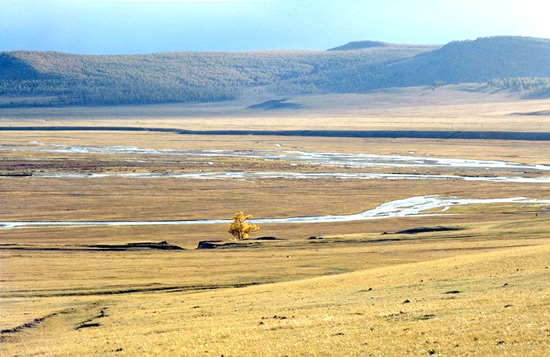
Physiography
The mountain grasslands cover type of the western Mountain States consists mainly of open, untimbered areas, yet it is often adjacent to or surrounded by ponderosa pine, Douglas fir, or lodgepole pine at moderate elevations. At high elevations the cover type is sub-alpine and is on mountain slopes or faces adjacent to spruce-fir forests and patches of alpine fir or whitebark pine.
It also occupies some of the best drained soils of valley-like areas intermingled with mountains, and it occupies various foothills, tablelands, and low mountains. The higher mountain settings can be rich with streams and lakes. These beautiful pastoral openings and exposures commonly provide unobstructed mountain vistas that are not observable from mountain terrain completely cloaked in forest.
Climate
The normal length of the frost-free season in most of the mountain grasslands cover type is 120 days. In the mountain valleys of the northern Rocky Mountains, however, it is less than 120 days, being only 80 days or less at high elevations. Annual precipitation in much of the cover type is 20 inches, and in the high mountains it is 30 inches or more. During the warmest months in central Colorado and east of the Continental Divide in Montana, 66-75 percent of the precipitation falls. In the northern Rocky Mountain grasslands west of the Divide, 50-66 percent comes during the warmest months, and in the Palouse hills of the Northwest, only 25-40 percent comes during this period. Annual precipitation is 30-35 percent of the evaporation potential.
Vegetation
Although the mountain grasslands cover type ranges from foothills at northerly latitudes to high mountain sites, it is characterized throughout by bunchgrasses of the fescue and wheatgrass groups.
Fauna
In the foothills portion of the mountain grasslands cover type, pronghorn, or antelope, are resident and mule deer are winter visitors. Where there is an interface with the sagebrush cover type, common animals are the black-tailed jackrabbit, pygmy cottontail, and various mice. At low to medium elevations, various subspecies of ground squirrels are present, as well as the badger.
At medium to high elevations, the grasslands seasonally support Rocky Mountain elk and mule deer. The pocket gopher is well distributed throughout the cover type. Predators, which are well distributed at high elevations, are the bobcat, black bear, and coyote. Two of the more common birds present are the robin and horned lark. Marsh hawks, sparrow hawks, and golden eagles are common raptors.
Soils
In central Colorado the cover type occupies Aridisols and Mollisols with developed horizons. In the Yellowstone River area of south-central Montana, the grassland soils are Entisols with no horizon development. In the grasslands of the northern Rocky Mountains, the soils are Alfisols and Mollisols. Mollisols are also the major soils of the Columbia Plateau's foothills or Palouse hills. Much of the central and eastern portion of rolling hill land is locally termed part of the Palouse Prairie and has wind-laid soil of great depth.
Land Use
Much of the cover type at lower elevations or on foothills was plowed soon after settlement for production of small grains, most notably the Palouse Prairie hills of north central Oregon and the extreme eastern portion of Washington and adjacent parts of Idaho. Unbroken portions of the foothill grasslands on steep slopes and in canyons are used as spring-fall range for livestock and as winter range for big game.
Data Source: United States Department of Agriculture, Forest Service
The Mountain Meadows
Cover Type
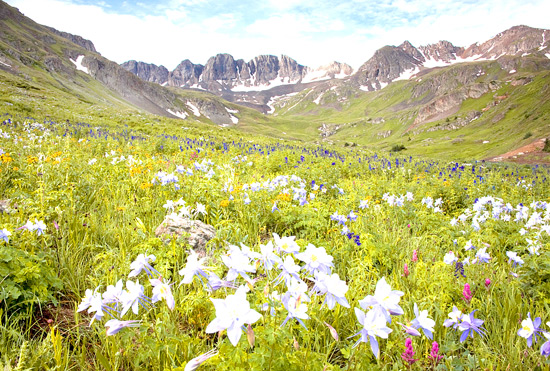
Physiography
The mountain meadows cover type consists of wet to intermittently wet sites in the forest zone of mountains in the western states. Typically it occurs on almost flat to gently sloping topography, as in valleys and basin-like areas along lakes and streams, where surface or subsurface water accumulates in the root zone for at least part of the year.
Climate
Saturation of the soil in this cover type during at least part of the growing season is strongly related to local topography or geology, rather than to the climate of the cover type. There must, however, be adequate annual precipitation on the site or runoff from higher areas to create the soil moisture conditions necessary to the development of the meadows. The temperature regime of meadows is generally that of the surrounding areas, yet in some cases, meadows are the sites of frost pockets in which temperatures deter establishment of some forest stands as effectively as intermittent high moisture in the rooting zone.
Vegetation
Grasses, sedges, rushes, and, in some cases, phreatophytic shrubs dominate the mountain meadows cover type. Under the best conditions, 70 percent of the ground is covered by vegetation, more than three-fourths of which may be perennial grasses. Sedges may constitute as much as 15 percent of the cover. Perennial forbs with showy flowers make up only about 10 percent of the cover. The proportions of the various growth forms are easily manipulated by the degree and timing of grazing.
Fauna
In many places this cover type contains lakes and streams that provide water for wildlife, and it is usually more productive of herbage than surrounding areas. Thus, it attracts fauna daily from the larger cover types in which it occurs. The wetter meadows, especially those with streams or permanent lakes, are a home for such wildlife as beaver, waterfowl, and fish.
The fauna of intermittently wet meadows may shift as moisture conditions change. For example, the burrowing rodents and the predators that feed on them use the meadows only during the drier periods. Deer, elk, and moose are among the large mammals that, although they use heavy timber sites for cover, depend heavily on meadows for food. In large expanses of forest and rangeland, the meadows are about the only suitable habitat for the nesting of migratory waterfowl.
Soils
Soils of mountain meadows commonly have been, and currently are, recipients of alluviation, illuviation, or glaciation products from above. Consequently, no classification by soil orders is attempted for this cover type.
Land Use
Small, high-elevation mountain meadows commonly have not been cultivated. Only at lower elevations or in more accessible areas have meadows been converted to hay land or drained and farmed. On the other hand, many small mountain meadows have been obliterated by road building and trails made by horses used for recreation. Disturbances to plant cover have, in some cases, resulted in the cutting of streambeds to such depths that the water table has been lowered. Where this has happened, the meadows have lost their productive herbaceous cover and have been invaded by brush or lodgepole pine stands.
Data Source: United States Department of Agriculture, Forest Service
The Plains Grasslands
Cover Type
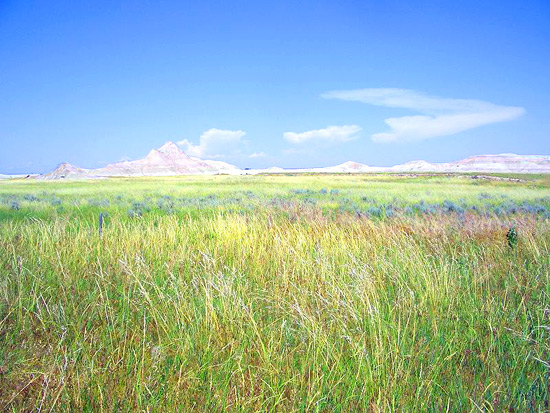
Physiography
The plains grasslands cover type, also known as the Great Plains, occurs on a broad belt of high land that slopes gradually eastward and down from an altitude of 5,500 feet near the eastern foothills of the Rocky Mountains to an altitude of 1,500 feet in the central states, where it gives way to the prairie cover type.
The most striking feature of the cover type is the phenomenal flatness of the inter stream areas, which make up a great expansive fluviatile plain or alluvial slope. The eastern margin has been most exposed to erosion, being near the trunk line of drainage and in a climate of greater rainfall than the western edge. The plains grasslands cover type of 280 million acres is larger than any other vegetation region in the United States.
Climate
Temperatures vary considerably, the frost-free season ranging from less than 100 days in the north to more than 200 days in Texas. The cover type is characterized by periodic droughts. Average annual precipitation ranges from 10 inches in the north to more than 25 inches in the south, 68-80 percent of the precipitation falling in the warmest months. Normal annual pan evaporation is roughly four times the precipitation. Precipitation ranges from about one-third to one-half of potential evaporation.
Vegetation
Short, warm-season grasses predominate in this cover type, and there is a minor interspersion of forbs and shrubs. Vast stretches are dominated almost exclusively by blue grama, buffalo grass being a companion in many areas. The eastern part of the cover type, however, is dominated by grasses of medium stature, such as western wheatgrass and needlegrass. The occasional shrubs include juniper, silver sagebrush, silver buffalo berry, and skunk bush sumac in the northern reaches and rabbit brush and mesquite in the southern part. Forbs are generally quite common, but many are ephemerals.
Fauna
Huge herds of American bison once migrated with the seasons across the central plains. Currently, the pronghorn, or antelope, is probably the most abundant large mammal, but mule deer and white-tailed deer are often abundant where brush cover is available, as along stream courses. The white-tailed jackrabbit occupies the northern part of the cover type, and the black-tailed jackrabbit can be found in the area south of Nebraska. The desert cottontail is widespread. The lagomorphs, the prairie dogs, and a variety of small rodents are preyed upon by the coyote and a number of other mammalian and avian predators, one of which, the black-footed ferret, is classed as an endangered species. The wolf once existed on the plains in great numbers, feeding to a considerable extent on bison.
The lesser prairie chicken, formerly abundant, is now classed as a rare species. Sage grouse, greater prairie chickens, and sharp-tailed grouse are present in the area. Among the many smaller birds are the horned lark, lark bunting, and western meadowlark. The endangered golden-cheeked warbler is in the southeastern portion of the cover type in places where the Ashe juniper is present. Stock pond construction has created an important "duck factory" in the northern Great Plains.
Soils
The soils of this cover type are varied. Mollisols occur from the Canadian border to the southern boundary of the cover type in Texas, as do Entisols. Alfisols and Aridisols are less extensive and are mostly in the southern portion.
Land Use
Large areas of the most productive sites have been converted to crop farming; the remainder is rangeland.
Data Source: United States Department of Agriculture, Forest Service
The Alpine
Cover Type
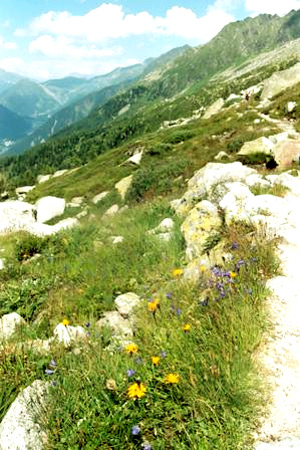
Physiography
The alpine cover type occurs largely as an interrupted chain of stands on the highest peaks in the Rocky Mountain and Pacific Mountain systems. Valley glaciers have sculptured most alpine areas and provided open, spectacular landscapes. Cirques, hanging tributaries, and various types of moraine are common.
Climate
The climate is rigorous. The average monthly temperature may be 3°C in January and 50°C in July. Frost may occur any night during the summer. Precipitation is estimated to be 35-50 inches per year, falling mostly as snow. Evaporation and wind movement are marked.
Vegetation
Grasses and grasslike species of rather low stature predominate, but the number of associated forbs is large. Dwarf willows occur in some places on the moist soils of protected slopes and valleys.
Fauna
The pika, pocket gopher, and yellow-bellied marmot are the only permanent mammalian residents of the alpine cover type. Summer visitors include mule deer, elk, mountain sheep, weasels, marten, chipmunks, and the golden-manteled ground squirrel. The only nesting birds are the horned lark, water pipit, black rosy finch, rock wren, white-tailed ptarmigan, and robin.
Soils
The soils of this cover type commonly have no pedogenic horizons (Entisols), have weakly differentiated horizons (Inceptisols), or have a low supply of bases and an accumulation of amorphous materials in subsurface horizons (Spodosols). These cold soils normally belong in the cryic great groups. The terrain is sometimes referred to as "fragile," because of the ease with which the soils can be displaced by horses' hooves on recreation trails or water eroded where ground cover becomes broken.
Land use
This cover type provides summer grazing for sheep under careful management. Their deep snowpacks make areas in the cover type prime watersheds. The cover type provides opportunities for summer and winter recreation and habitats for wildlife.
Data Source: United States Department of Agriculture, Forest Service
Copyright © 1993-2025 World Trade Press. All rights reserved.


